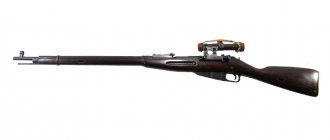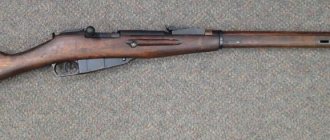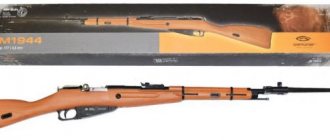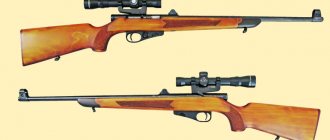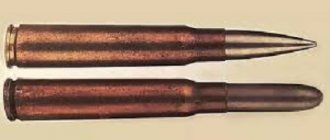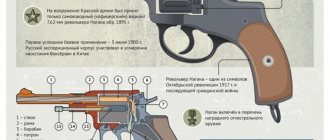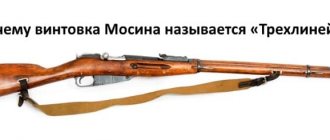Review of carbines OTs-48/48K
Why did the old model of the early 20th century interest modern weapon designers? The thing is that during testing it was discovered that the famous three-ruler rifle from a distance of 100 m puts bullets in a circle with a diameter of 3.5 cm, while the standard sniper rifle - SVD, puts bullets in 8 cm from 100 m. In addition, when With automatic reloading, the accuracy of fire drops even more. This problem does not exist in the three-line
As a result, small arms stored in warehouses have found a new life. The OTs-48 carbine is manufactured by modifying the Mosin sniper rifle. The weapon has been thoroughly modified in order to successfully use the advantages of the rifle and compensate for its shortcomings.
Rifle OTs-48K (photo)
Advantages and disadvantages
The OTs-48 carbine was created as a hunting weapon and as a sniper version for special forces - for the latter there is a combat modification OTs-48K. The barrel and locking unit remained from the three-ruler, and the stock and butt were installed more modern.
As a result of all the alterations, the model received the following advantages.
- Accuracy – from a distance of 100 m you can shoot at a target with a diameter of 3.5 cm.
- The maximum sighting range is almost 1300 m, which is greater than the firing range of the SVD.
- Soft descent – “sporty”. This required corresponding changes in the trigger mechanism.
- Folding front sight – provides more convenient transportation and does not interfere with the use of an optical sight.
- A flame arrester appeared on the barrel.
- The buttstock is raised - for working with an optical sight, and is equipped with a butt plate. The latter has a convenient shape and is made of rubber. Unfortunately, this deteriorated the appearance of the carbine.
- It is possible to attach an anti-mirage film - this prevents the barrel from heating up in the sun and prevents air vibrations in front of the sight.
- The combat modification of the rifle - OTs-48K, is carried out according to the "bullpup" scheme. This made it possible to reduce the length of the weapon to 850 mm.
However, the product has some disadvantages.
- The design of the carbine can hardly be called modern: the axis of the barrel rises above the buttplate, which in itself contradicts the idea of a “bullpup”.
- The bolt in the Mosin rifle was not initially distinguished by its easy movement. This problem is not eliminated in the carbine. On the contrary, the bolt is connected to an extension, which makes it difficult to operate. In combat conditions, if cleaning is impossible, an ordinary person simply will not be able to move the bolt with one hand. This quality significantly reduces the weapon's rate of fire.
- The sliding bolt is located above the butt, and not in it, which can lead to blows to the face if reloaded sharply.
- The rifle's optical sight is shifted to the left. In addition, there is no way to detect a violation in the zeroing of the optics, except by the results of the shooting.
Varieties
They produce 2 modifications of the model with slightly different purposes.
- OTs-48 is a sniper rifle for high-precision shooting, the main purpose of which is hunting large animals. The OTs-48 TOZ carbine cartridge is 7.62x54R, including the high-precision sniper 7H1.
- OTs-48K is a military modification, used in special forces. The model is produced in small series and only to order. Instead of a flame arrester, you can wear a muffler. The main sight is a four-fold PSO-1 or a seven-fold PKS-07. Instead of a day sight, you can install a night sight, like the PKN-03.
Sniper rifle "OTs-48 / OTs-48K"
In 2000, the young designer of the Tula Central Design Bureau of Sports and Hunting Weapons (TsKIB SOO) - Vladimir Zlobin, proposed to revive the legendary three-line Mossin model of 1891/1930 in a new guise.
He proceeded from the fact that in the hands of sports shooters and experienced snipers, individual examples of Mossin rifles showed an accuracy of 3.5 cm per 100 m compared to 8 cm for the SVD.
This is a normal result for a linear rifle of the late 19th century, but not for a sniper weapon of the early 21st century. In the new century, sniper weapons should have an accuracy of better than 24 mm at 100 m, 7 cm at 300 m, 35 cm at 1200 m. OTs-48
The new version of the Mossin rifle received the designation OTs-48.
In the new rifle, the free-floating barrel carries a short flash suppressor and a front sight post.
Locking is done by turning the sliding bolt with the handle bent down. The bolt has a hammer with a cocking mechanism and a hammer protruding from the rear.
The trigger mechanism is made softer and more convenient for high-precision shooting than that of the prototype.
The solid wooden stock has a butt with an adjustable butt and cheekpiece, and a mount for a hinged bipod at the front end of the forearm.
| OTs-48K on bipod |
The OTs-48K (“short”) modification is made with elements of a bullpup design, which reduces the length of the weapon to 850 cm versus 1225 cm for the SVD.
OTs-48K when firing,
the shutter is controlled through a special rod connected to it by a pair of hinged levers.
The permanent magazine is completely integrated into the stock behind the pistol grip, which is integral with the stock.
The buttstock is raised enough to ensure ease of operation with an optical sight, and is equipped with an elastic butt. The butt plate is made of rubber and has a fairly comfortable shape.
| OTs-48K |
An anti-mirage tape can be attached above the barrel, which prevents uneven heating of the barrel by the sun and at the same time the appearance of air vibrations in front of the sight from the barrel heated by shooting.
| OTs-48 | OTs-48K | |
| Caliber, mm | 7.62×54 (7H1) | |
| Length, mm | 1250 | 850 |
| Barrel length, mm | 730 | |
| Weight without cartridges, kg | 6.0 | 5.5 |
| Magazine capacity, no. cartridges | 5 | |
| Sighting range, m | 800 | |
The rifle is equipped with a bipod mounted on the front end of the forend.
The rifle has a mechanical sight consisting of a rear-folding front sight and a frame sight, similar to the sight of the 1930 model. The optical sight is shifted to the left.
The main one is a four-fold sight PSO-1 or a seven-fold PKS-07. Also, night sights like PKN-03 or mechanical sighting devices can be installed on a sniper rifle.
Instead of a flash suppressor, a PMS (tactical silencer) can be attached to the barrel.
Both rifles are made to order only.
The rifle is intended for arming mobile units (special forces, airborne forces, etc.), and is used to defeat openly located manpower, including those using personal armor protection, as well as unarmored vehicles.
| OTs-48K |
Specifications
| Options | OTs-48 | OTs-48K |
| Caliber, mm | 7,62 | 7, 62 |
| Length, mm | 1250 | 850 |
| Barrel length, mm | 630 | 730 |
| Weight without cartridges, kg | 6,0 | 5,5 |
| Magazine capacity | 5 | 5 |
| Sighting range, m | 1000 | 1000 |
Weight is given with the PKS-07U optical sight.
On November 28, 1927, on the basis of the Tula Arms Plant, the Small Arms Design Bureau (PKB SV) was created - the country's first large organization for the development of small arms and artillery weapons, which in 1937 was transformed into TsKB-14.
For the first thirty years of its history, design bureau employees were engaged in the design of small arms, machine guns and aircraft cannons. Among the small arms created in the pre-war period are the developments of F.V. Tokarev (7.62 mm TT pistol and SVT self-loading rifle), M.E. Berezin (several variants of a 12.7 mm machine gun, UB-12 universal machine gun, 7 and 20-mm B-20 aircraft cannon), A.A. Volkov and S.A. Yartsev (VYa-23 aircraft cannon).
In the post-war period, from this design bureau the army received the A-12.7 machine gun, AM-23 cannons (N.M. Afanasyev and N.F. Makarov) and GSh-23 (V.P. Gryazev and A.G. Shipunov), pistols of the PM series (N.F. Makarov) and APS (I.Ya. Stechkin), a 2A14 assault rifle (N.M. Afanasyev) for arming the Shilka anti-aircraft complexes and the ZU-23 installation (R.Ya. Purtsen).
By order of the People's Commissar of Armaments of the USSR No. 96 dated March 4, 1949, the Central Design Research Bureau of Sports and Hunting Weapons (TsKIB SOO) was created as the head organization of the industry for sporting and hunting weapons, now a branch of the State Unitary Enterprise "Design Bureau of Instrument Making" - the state unitary enterprise "Konstruktorskoye" Bureau of Instrumentation".
Currently, hunting and sporting weapons TsKIB SSO (factory index MC) and military weapons (factory index OTs) are known all over the world. Over the past years, the designers of TsKIB SOO have created a number of unique types of military weapons with the OC index - pistols and revolvers, rifles and machine guns. The range of developments of TsKIB together with KBP over the past 10 years amounts to more than 20 items, types, models and even circuits.
One of the most important areas of work of TsKIB, which has extensive experience in the development and creation of high-quality sporting target weapons, is the development of such models of sniper rifles as the MTs-116M, OSV-96/V-94/SV-94, OTs-03, OTs-44 models and OTs-48. This is what is written about the last of them, OTs-48, in an article in the newspaper “AiF Analysis”
No. 19(64) dated October 12, 2000
“Snipers: yesterday, today and tomorrow”
Sergey OSIPOV
“...There are projects in sniper business that are quite strange at first glance. The young designer Vladimir Zlobin from Tula proposed to revive the good old three-line Mosin model of 1891/1930. It unexpectedly revealed a number of advantages over the standard “sniper” of the Russian SVD Army. Firstly, in those days, barrels were produced using the planing method, and not using electrochemistry, as now. Of course, gunsmiths could not have dreamed of the current productivity 100 years ago, but the quality was higher. During testing, the first three-ruler that came across, from a distance of 100 meters, placed bullets in a circle with a diameter of 3.5 cm. The SVD has this circle, and according to the standard, that is, ideally, it is 8 cm!
Secondly, with automatic reloading, which the SVD has, the accuracy of fire is reduced even more. The three-ruler does not have this problem initially. By the way, the question of what a sniper rifle should be: automatic, or a classic “magazine”, has been debated for about 50 years. There is no consensus on this matter yet...
The new-old rifle, which is now called OTs-48, shoots at a distance of 1300 meters. Equipped with a silencer-flame arrester, a soft trigger, a bipod and modern optics, the three-line rifle has turned into a very fashionable and “sophisticated” rifle. In one of the modifications - OTs-48K - it is configured according to the bullpup design, which reduces the length of the weapon to 850 cm versus 1225 for the SVD. So it is possible that the life of the Mosin rifle will be extended into the third century with the awarding of the honorary title “model 1891/1930/2000”…”
So, to summarize:
OTs-48
- Cartridge used - 7.62 x 54 mm (7H1)
- Maximum range - 1000 m
- Barrel length - 730 mm
- Overall dimensions of the rifle: Length with compensator - 995 mm
- Width - 68 mm
- Height - 218 mm
Can be equipped with a specially designed muffler
OTs-48K
- Length - 850 mm
Design
The OTs-48 carbine is the main modification, although it is also made to order. The “raw materials” in the literal sense of the word are Mosin rifles stored in military warehouses. For modification, the best specimens in terms of shooting accuracy are selected from a batch of weapons and sent for modification.
- The barrel and locking assembly remain unchanged: a barrel made using the old, almost “manual” technology has better characteristics, while it is now economically unprofitable to produce the part in this way.
- The trigger mechanism has been redesigned to provide a smoother release.
- The sliding bolt is connected to an extension and is equipped with a handle bent down. In the bolt there is a firing pin with a combat platoon. The shutter is the main disadvantage of the product, since it requires noticeable effort when reloading.
- The magazine is permanent, the Mosin system is inscribed in the butt, and is made together with the stock. The cartridges have to be pushed into the magazine one at a time.
- The standard folding bipod can be hidden in the stock - there is a special niche.
In the shortened version, the combat carbine, the firing mechanism and firing handle are placed forward of the receiver. In this way, the length of the rifle is reduced.
Carbine OTs-48 TOZ (KBP) 7.62x54
OTs-62: an unusual hybrid of a revolver and a shotgun
The Russian arms industry produces a huge range of weapons for various purposes, including quite unusual designs. Such samples can easily be attributed to the OTs-62 revolver, which was designed by specialists from the Central Design Research Bureau for Sports and Hunting Weapons (TsKIB SOO). This enterprise, located in Tula, has developed and produces a large assortment of small arms, the most famous models of which include the OSV-96 and VKS sniper rifles, the ADS double-medium assault rifle, the GSh-18 pistol and the OTs-38 silent revolver. Unfortunately, not much information can be found about the development of the OTs-62; all that is known is that this revolver appeared as a further development of the MTs255 single-barreled revolver shotgun, which was developed for hunting medium-sized game. On the basis of this gun, a police version of the MTs255-12 (chambered 12/70 and 12/76) was created at one time. This gun was intended for arming law enforcement agencies and security forces and was distinguished by fittings made of black plastic, the presence of a Picatinny rail and a folding butt. Judging by the lack of information that disappeared from the official website of the developer company, the company’s new products did not find their buyer, and there is no information about the use of the models by security forces.
When talking about these models, it is necessary to return to the early 1990s, when domestic gunsmiths and law enforcement officers tried to jointly understand what kind of arsenal law enforcement agencies should have in the new realities. In those years, the idea of a large-caliber revolver as a universal personal weapon for an employee was quite widely discussed. The concept involved combining the simplicity and reliability of a revolver with the ability to use a wide range of available ammunition. We were talking not only about ordinary bullets with increased stopping power, but also about special ammunition (armor-piercing, grapeshot and non-lethal). Given that Russian companies have no experience in developing modern revolver cartridges, they chose the 32nd hunting caliber as the basis (depending on the type of barrel, the nominal caliber of such revolvers was designated as 12.3-12.5 mm). As part of the implementation of the designated concept, some models of weapons were created that were positioned on our market as weapons for government organizations with special statutory tasks (“Udar”, “Grom”), or as weapons for private security structures (“Udar-S”, "Dog-1").
In practice, the idea turned out to be unclaimed; law enforcement agencies did not have enough money to purchase such “exotic” weapons, and private security companies preferred to arm themselves with the familiar and well-known IZH-71 service pistol. In many ways, Russian gunsmiths were characterized by an attempt to stay ahead of the requirements of the existing market. Following the OTs-20 revolver, which was created as part of work on the R&D project “Udar”, TsKIB SOO thought about creating a hunting revolver rifle. The OTs-20 revolver used 12.3x40 mm R cartridges for firing, which were 32-caliber rifle cartridges with a sleeve shortened to 40 mm. In total, no more than 200 of these revolvers were produced in Tula.
The new MTs255 showed some similarities with the OTs-20. Initially, the weapon was produced only in the 20th hunting caliber, but over time modifications of .410 and 12th caliber appeared, as well as a version for law enforcement agencies with a folding stock. It should be noted here that in TsKIB SOO, models with the MC index (“TsKIB SOO model”) since 1948 are models of hunting, sporting and civilian weapons, models with the OTs index (“TsKIB SOO model”) since 1960 are military weapons.
The MTs255 revolver shotgun was developed by Tula designers TsKIB SOO in the early 2000s. This model of weapon uses a classic revolver design - a drum designed for five rounds is tilted to the side, and spent cartridges are simultaneously ejected when the spring-loaded rod of the drum is pressed. Trigger mechanism MTs255 double action (you can shoot by self-cocking, you can pre-cock the trigger with your finger). Positioned as a weapon for hunting medium-sized game, this gun was produced in three calibers - .410 (10.4 mm), 20-gauge (15.6 mm) and 12-gauge (18.5 mm). Users of this weapon noted the low service life of the revolving gun and the insufficient reliability of the model with some types of ammunition. In addition, in practice, spent cartridges were not removed with a rod; they had to be removed one at a time, squeezing them out with a finger or a ramrod.
Revolver OTs-62
The tactical version for security forces was distinguished by the presence of Picatinny-type rails for placing target designators, tactical flashlights and collimator sights and a folding metal butt. Especially for police units, the OTs-62 traumatic revolver with a 200 mm barrel was created on the basis of the MTs255. Externally, the weapon resembled something between a small gun and a revolver that had grown in size. The TsKIB SOO advertising brochure stated that the OTs-62 revolver is intended to arm special law enforcement units during operations to detain violators of public order, disperse unauthorized demonstrations, etc. The revolver uses rifle cartridges equipped with a rubber bullet.” In fact, the weapon was a sawn-off shotgun MTs255 with a shortened barrel and without a stock chambered for the new 12/67 mm cartridge.
Having missed the chance to enter the market with the Udar revolver, the Tula enterprise could count on the fact that the OTs-62 in the future could be considered not only as a weapon for law enforcement officers, but also as a service or civilian weapon. Some experts believed that if the developers of the OTs-62 had risked moving further away from the prototype, their model would have had a greater chance of success. But the heavy weight of the revolver-gun - 2.5 kg (without cartridges), which was inherited from its progenitor, significantly limited the tactical range of use of this weapon. So the security forces could not carry such non-lethal weapons in addition to their service weapons. At the same time, the weight of the model could be reduced if the developers switched from steel to light alloys and impact-resistant plastic.
The OTs-62 differed from other previously developed revolvers “Gnome” and “Udar” in its size; it was simply huge. Classifying weapons was quite difficult. Externally it is a revolver, but it is too large, has a smooth barrel, allowing the use of shotshells and a forend. The revolver's drum held five 12-gauge cartridges, but not the common hunting 12/76 mm, but the slightly weaker 12/67 mm. The rear of the weapon is completely revolving, while the front has a handguard with a shield. You may ask what is the shield on the front for? The whole point is that the OTs-62 barrel has a length of 200 mm, for a revolver this is a very large value, but for a shotgun it is not enough, but the cartridges used, albeit shortened, are quite powerful 12 gauge. When fired, a flame flies out of the barrel, which would simply burn the shooter’s hand if not for the presence of a shield.
Revolver OTs-62
At the same time, in Tula the OTs-62 was primarily positioned as a weapon for firing non-lethal ammunition, mainly with a rubber bullet. The use of shot cartridges is also possible, but only in exceptional cases. As a result, there are weapons that are incredibly small for a shotgun and too large for a revolver, capable of firing both non-lethal and conventional ammunition. At the same time, the weapon has serious recoil, which cannot be reduced; the revolver does not have a stock or a muzzle brake-compensator. Therefore, you can shoot from it only by holding the weapon with both hands, the other by the fore-end.
Nothing is known about the production volumes and use in law enforcement agencies of this hybrid of a smoothbore shotgun and a revolver; at least, there is no information about this in open sources. Perhaps the weapon could find its buyer on the civilian market. At least, it was possible to scare off attackers with just the appearance of the weapon, but on the other hand, the total length of 366 mm and weight of 2.5 kg are also not the best characteristics for a civilian traumatic weapon.
Tactical and technical characteristics of OTs-62: Caliber – 12th Cartridge – 12/67 mm. Weight – 2.5 kg (without cartridges). Length – 366 mm. Barrel length – 200 mm. The magazine is a revolver drum with 5 rounds. Target firing range – 50 m.
Options and packaging
The OTs-48 carbine is offered with the following configuration:
- sights: day sights - four-fold PSO-1 or seven-fold PKS-07, night sights - PKN-03;
- flame arrester;
- PMS tactical silencer – mounted on the barrel instead of a flash suppressor;
- antimirage tape;
- shooting glasses;
- gun oil from different manufacturers;
- case for optical sight;
- gun case;
- anti-noise headphones.
For firing from the OTs-48 TOZ KBP carbine, a 7.62 x54 cartridge is used. fit:
- Tompak Refinery cartridge – bimetallic sleeve, Tompak bullet jacket. Weight is 13 g;
- Extra cartridge - tombac shell, brass sleeve. The tombak shell has minimal effect on the condition of the barrel;
- refinery noise cartridge – with a bimetallic sleeve;
- cartridge with increased accuracy - tombak shell. Bullet weight 9.9 g;
- S&B cartridge with semi-jacketed bullet. Weight – 11.7 g. It has very high ballistic characteristics.
Operating principle
OTs-48K belongs to the type of carbines with a bolt action - a longitudinally sliding bolt with manual rotation. This mechanism locks the barrel due to the lugs entering the grooves of the receiver. The design is simple, but nevertheless withstands high pressure of powder gas, so that when shooting from a bolt-action carbine, you can use cartridges of greater power.
The operating principle is as follows:
- the barrel bore is closed when supported from the breech end by the bolt, which has come to the forward position;
- locking prevents possible release of the bolt due to gas pressure during firing;
- when fired, the bolt is held at the breech;
- after the shot, the bolt is unlocked - it disengages from the barrel and opens the barrel;
- the bolt is pulled back, opening the bore. They are recharging.
The main disadvantage of a bolt action is the need for force when reloading. In the OTs-48, reloading is even more difficult due to the extension cord.
Disassembly
To inspect and clean the carbine, partial disassembly is carried out. Full is required during repairs or in case of severe contamination of the weapon. It is recommended not to repeat the operation too often, since complete disassembly contributes to rapid wear of parts. Assembly and disassembly is carried out on a table or clean mat. Be sure to check whether the weapon is unloaded.
Sequence of incomplete disassembly.
- Press the trigger, and with the other hand open and remove the bolt.
- Unscrew and lift up the cleaning rod.
- Remove the magazine cover from the hinge bolt.
- They disassemble the bolt: holding the combat cylinder and handle, pull the trigger and, turning to the left, release it, then move the bar with the cylinder forward and disconnect it from the bolt stem. The larva is separated from the bar. In a vertical position, press the handle of the stem, compress the mainspring and unscrew the hammer from the firing pin. Smoothly release the bolt stem and remove the firing pin.
- Lastly, remove the spring from the hammer.
Reassembling the carbine after cleaning and lubrication is done in the reverse order.
Complete disassembly includes separating the barrel from the stock and disassembling the trigger mechanism. Separating other parts is only possible in a weapons workshop.
Comparison of OTs-48K with a sniper rifle
Review of the large-caliber rifle OTs-44
OTs-44 is a Russian single-shot special-purpose sniper rifle. Is a prototype. The rifle is designed for sniper fire with 12.7x108 mm cartridges. The rifle's design has an integrated sound dissipation and flash suppressor. The rifle was designed by the TsKIB SOO design bureau in Tula. When creating the rifle, the design of L.V. was used. Bondareva. Unfortunately, there is little information about this rifle and the description of the rifle may be distorted or incorrect. Please note that we are talking about a sound diffuser and not a muffler, since the ejection speed of the cartridge is 800 m/s.
Throughout their history, large-caliber rifles have been popular in all countries of the world, and every country wants to have them in service. A large-caliber rifle is capable of performing tasks that conventional sniper rifles cannot: defeating lightly armored targets and enemy personnel at a distance of 1500 meters or more. The problem with many large caliber rifles is their size and the powerful sound of the shot, which gives away the shooter's position. Therefore, gunsmiths are trying to create large-caliber rifles with a silencer chambered for standard cartridges. As a rule, such attempts end with the rifles being oversized. Domestic gunsmiths decided to take several paths. The first way was to create a subsonic 12.7 cartridge and a rifle with an integrated VSSK Vykhlop muffler. The second way is to reduce the sound to the level of a shot, like an SVD rifle. When creating the OTs-44 rifle, the designers decided to take the second route.
When creating the rifle, it was decided to use the “Bullpup” design - the trigger mechanism and the chamber are located behind the trigger, and the sound diffuser is integrated into the design of the rifle, like the VSS Vintorez rifle, since with this solution the dimensions and weight of the rifle became reasonable . of the OTs-44 rifle was born . The length of the rifle is 1070 mm, with a weight of 14 kg, which is an excellent result for a weapon chambered for 12.7 mm, in addition with a sound diffuser. Of course, the sound dispersion device negatively affects the sighting range, which is 1200 meters, with bullet speed 800 m/s. Another interesting point in the design of the weapon is manual reloading, for which it is necessary to move the barrel forward. This design solution is associated with a reduction in the dimensions of the rifle; on the other hand, the movable barrel negatively affects the accuracy of the fire. For ease of shooting, adjustable folding bipods are provided. The bipod is attached to the receiver. To reduce the recoil force, the butt has a cheek rest and a rubber “overshoe” damper.
The rifle turned out to be too specific and not in demand among the military. The unpopularity of the rifle is confirmed by the scant information about it. At the same time, on the basis of the OTs-44, a rifle was created chambered for 14.5x114 mm; there is practically no information about this rifle, as well as about the OTs-44 rifle .
Performance characteristics of the OTs-44 Sniper Rifle
| Number of shots | 1 cartridge |
| Barrel caliber | 12.7x108 mm, 1100 mm barrel length |
| Combat rate of fire | no data |
| Maximum rate of fire | no data |
| Sighting range | 1200 meters (according to other sources 2000 meters) |
| Maximum firing range | no data |
| Effective shooting | no data |
| Initial departure speed | 800 m/s |
| Automation | manual, barrel sliding |
| Weight | 14-kg |
| Bullet energy | 17,000 J |
| Dimensions | 1170 mm |
Product prices
The price for the OTs-48 hunting carbine is 21,200 rubles. A used rifle may cost less or more, depending on the type of upgrades. But in this case, the choice must be especially careful, since any gun owner makes adjustments based on his own needs, skills and even anatomical features.
An undoubted advantage of the carbine is the ability to use the oldest cartridges along with modern products that meet the requirements of the PMK of the Brussels Convention. Accordingly, the cost of ammunition varies greatly:
- a typical noise refinery costs from 22 rubles. per piece;
- 20 pcs. in a tombak shell are estimated at 399–499 rubles;
- S&B cartridge costs from 2480 to 3220 rubles. for 20 pcs.
This video talks about the penetration ability of the 7.62x54 cartridge used on the OTs-48:
Owner reviews
- As a hunting carbine, the modification of the rifle has undoubtedly found itself: many owners note good accuracy of fire and the ability to work with a wide variety of cartridges.
- According to reviews, the bullet pierces through oak at a distance of 200 m.
- However, many gun owners are forced to resort to modifications: most often they express a desire to lengthen the front sight.
- The prospects for the combat version are not so rosy. Experts believe that the bullpup layout itself precludes the use of the OTs-48 carbine as a sniper rifle. In addition, the difficulty of reloading significantly affects the rate of fire. There is no practical data on how the carbine behaves in combat conditions.
Analogs
- The OTs-48 and OTs-48K carbine are modifications of the Mosin three-line rifle and have no other analogues. Experts believe that the model is quite suitable as a hunting rifle. However, its other purpose - a military weapon for special forces - did not justify itself. The design features of the bullpup layout do not allow us to obtain a suitable sniper rifle.
- You can still mention the Gletcher M1891 - a pneumatic sawn-off shotgun of the Mosin three-line.
- Among the good three-line models, we can also mention such models as the MP-43 with caliber 7.62x54 R, MP-18 MN.
The OTs-48 carbine is a completely viable modification of the Mosin rifle. The gun has an affordable price, has good ballistic characteristics, and, most importantly, allows you to use almost any cartridge. However, the choice of carbines is quite wide.
Use of the OTs-48K carbine by a sniper
OTs-25: AKM's younger brother
The OTs-25 carbine (above) and the AKM assault rifle (below), on the basis of which the OTs-25 was created
In the second half of the 80s. last century, the world experienced a time of detente. This led to the release of a large number of small arms in the USSR. At one time, large labor and financial resources were spent on the development and production of these samples, but suddenly no one needed these military weapons, and considerable funds were “thrown down the drain.” What could be done in such a situation?
The solution was found quite quickly! Designers of military small arms and sporting and hunting weapons joined forces and began to convert combat models into hunting and sporting weapons. Mosin and Dragunov rifles, Simonov carbines and Kalashnikov assault rifles were altered...
Many Russian enterprises made their contribution to the conversion process, including the Central Design Research Bureau of Sporting and Hunting Weapons (TsKIB SOO). In 1993, a well-known gunsmith, creator of a family of world-famous carbines based on the modernized AKM assault rifle, developed the OTs-25 self-loading hunting carbine chambered for 7.62x39 mm, intended for commercial and amateur hunting of large and medium-sized animals.
Hunting buttstock of the OTs-25 carbine and AKM assault rifle
In accordance with the functional purpose of the carbine, it is equipped with a new trigger guard: the trigger is moved back; a new hunting-type stock with a protrusion for the hand and under the cheek, a shortened magazine with a new latch for five rounds.
The carbine is reloaded using the energy of the powder gases diverted from the barrel into the gas chamber and the energy of the return spring. The barrel bore is locked with two stops when it is rotated by the bolt frame.
A trigger-type trigger allows only single fire and setting the safety.
The open sighting device allows targeted shooting at a distance of no more than 400 m.
The stock and fore-end are made of walnut or birch wood.
Overall, the carbine is a good purchase for a hunter, fisherman and collector.
OTs-25 (top) and AKM (bottom) magazines
CHARACTERISTICS OF THE OTs-25 CARBINE
| Caliber, mm | 7,62 |
| Weight, kg, no more | 3,7 |
| Weight of optical sight with bracket, kg, no more | 0,5 |
| Magazine capacity, cartridge. | 5; 10 |
| Sighting range with open sight, m, no more | 500 |
| Length, mm | |
| • carbine, no more | 965 |
| • trunk | 415 |
| Dispersion diameter of five bullets when firing at a distance of 100 m, mm, no more | 20 |
Self-loading hunting carbine OTs-25 chambered for 7.62×39 mm. Right view
Carbine OTs-25. Left view
